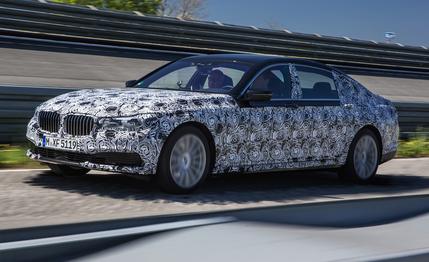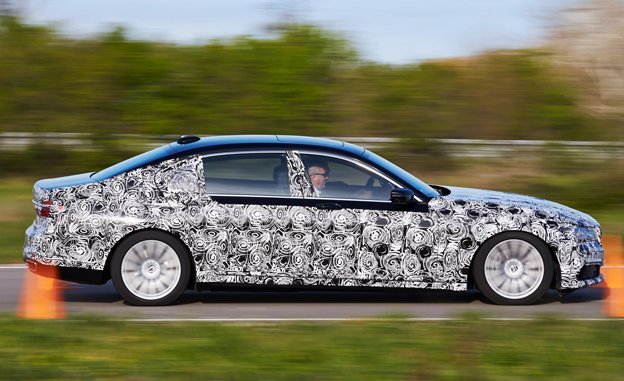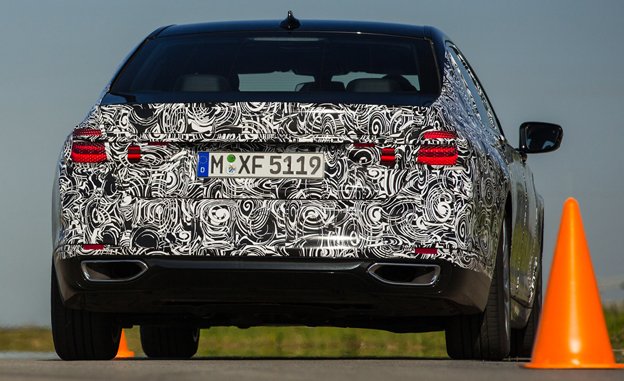
 Prototype Drive
Prototype Drive
Born in the teeth of the Great Recession, the fat but not so happy fifth generation of BMW’s 7-series flagship is finally relinquishing its post to a more fit successor.
The 7-series has traditionally been the BMW for those who can barely recall their stick-shift, tail-sliding days. Available in a choice of long or really long wheelbases, with up to 12 twin-turbocharged cylinders, and with rear- or four-wheel drive, the 7 is a four-door limo blessed with comfort, speed, and a suitably aloof demeanor.
Yet the world has changed since the current 7 arrived in 2009. Fisker came and went, Tesla emerged as the green-chip luxury brand, Mercedes is as strong as ever, and Cadillac is showing signs of intelligent life. The luxury-car business is flourishing so nicely that even the Korean brands are nibbling a thin slice of the pie.


BMW has made decisive moves to secure its future. Last year, the company’s engineering commander announced that electrification will spread beyond the i3 and i8 fashion statements and the current 3, 5, and 7 ActiveHybrids to include a plug-in hybrid option for every core model. BMW is the uncontested leader among automakers in weight-saving composite plastics with its own plant in Washington state producing affordable carbon fiber in partnership with the SGL Group.
Five years ago, fresh out of its shipping container, a 2010 BMW 750Li thumped a Mercedes S550 in a two-car comparison test, but the big Bimmer quickly lost steam. A 750i lost to Porsche’s new Panamera S while beating a Maserati Quattroporte Sport GT S. Then in 2011, a 750Li suffered the indignity of a distant third-place result versus Audi’s A8L and Jaguar’s supercharged XJL. The new 7 arrives late this year to make amends.
While we can’t announce mission accomplished after only eight paced laps around BMW’s Miramas, France, test tracks in early production cars, we’re encouraged by what we’ve learned about the 7 thus far:


• Project head Walter Schindlbeck acknowledges the need to restore the flagship’s neglected ride and handling strengths.
• Weight-saving technologies have been applied in earnest. BMW engineers have created an astute mix of high-strength steel, aluminum, magnesium, plastic, and carbon fiber materials to trim a claimed 285 pounds in base weight—a third of that from the body—while lowering the 7’s center of gravity and improving both bending and torsional stiffness. Several suspension and brake components have been switched from iron and steel to aluminum and sound deadening is used more sparingly. Unsprung weight drops by 15 percent.
• BMW is so proud of its innovative ‘carbon core’ unibody construction that a badge touting that technology is discretely affixed to each of the 7’s B-pillars. While stamped steel remains as the major constituent, there’s less of it thanks to the use of 15 molded carbon-fiber (CF) reinforcements added at strategic locations. The largest molding is a long CF tube that sweeps majestically from the base of each A-pillar, along the top of the door openings, and down to the base of the C-pillars. The upper half of each B-pillar is reinforced with a CF layer that’s pressed and cured in place with a single-sided die. A large patch is also secured with rivets and adhesives at the base of each C-pillar. The windshield header and two bows reinforce the roof structure. The 7’s center tunnel has a CF doubler to augment the body’s bending stiffness and to help manage forward collision loads. Add to that two CF door-sill inserts per side and a horizontal shelf beneath the backlight made of the black magic material. How exactly the CF and steel parts are joined with adhesives and fasteners and painting methods are proprietary information, as BMW naturally prefers to keep its learnings away from competitors as long as possible.